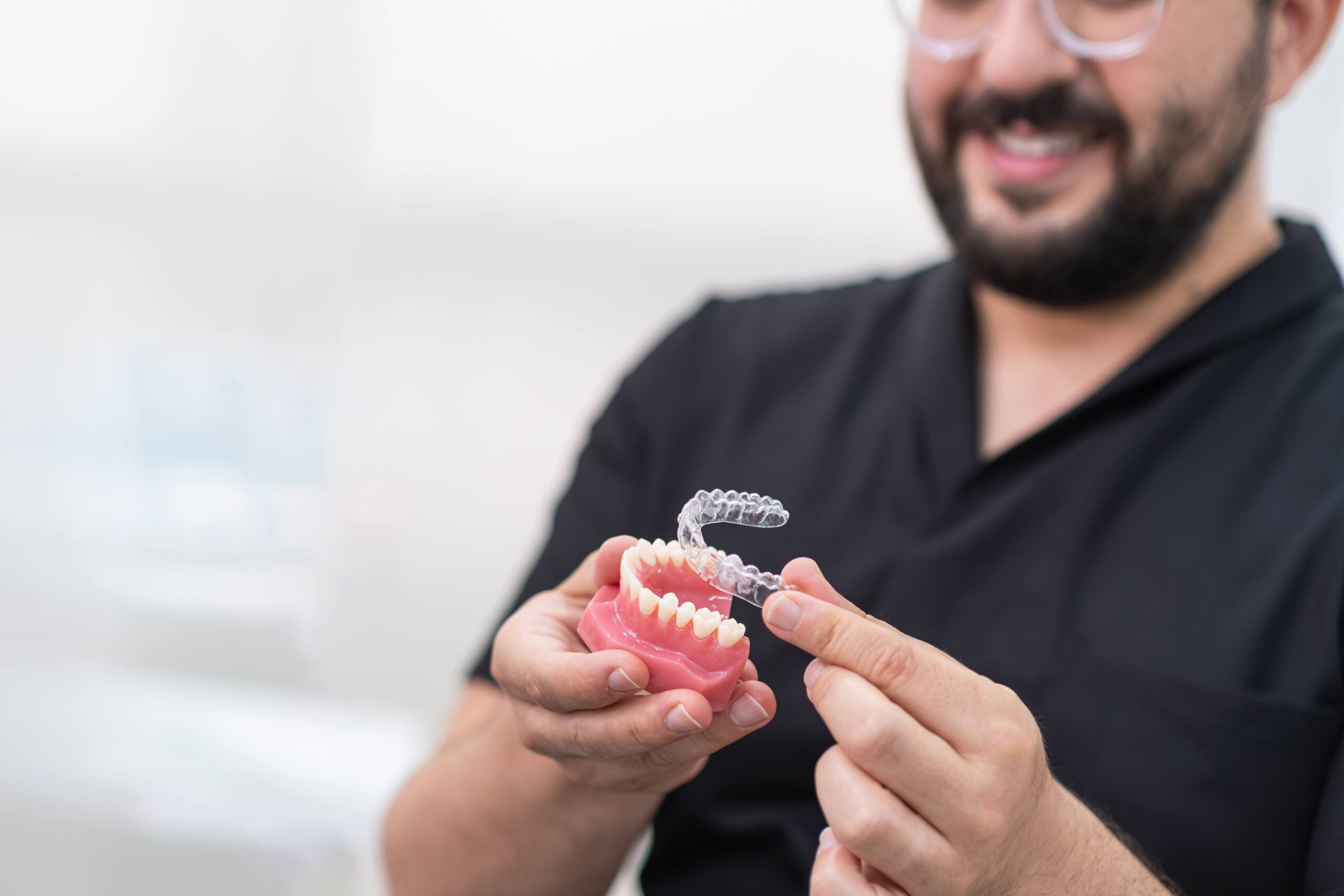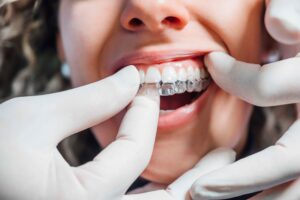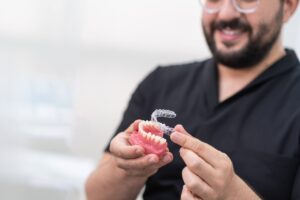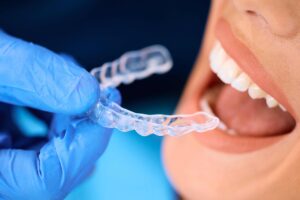Understanding Clear Aligner Therapy
Clear aligner therapy is a modern orthodontic method that offers a comfortable and nearly invisible way to achieve a perfect smile. Clear aligners, such as Invisalign, are plastic devices worn over the teeth to gradually shift them into optimal alignment. Each aligner is worn for approximately two weeks before moving on to the next in the series until the desired teeth and bite alignment is achieved.
Benefits of Clear Aligners
Clear aligners provide a host of advantages that make them a popular choice for orthodontic treatment. They are made of clear, flexible plastic that fits snugly over the teeth, making them less noticeable than traditional braces. Clear aligners are also removable, offering users more freedom and flexibility. They can be taken out for eating, brushing, and flossing, which allows for easier maintenance of oral hygiene and adherence to dietary preferences.
Clear aligners can correct a range of dental issues, such as underbites, crossbites, overbites, crowded teeth, and uneven spacing, improving both the quality of the smile and the appearance of the face. Furthermore, clear aligners are easy to fit, leading to minimal discomfort during the alignment process and contributing to a positive, confident smile (Smilecraft Dental).
Comparing Clear Aligners vs. Traditional Braces
While both clear aligners and traditional braces are effective in straightening teeth, they offer different experiences for the wearer. Traditional braces are fixed and may limit certain activities like sports and eating certain foods. On the other hand, clear aligners are fully removable, allowing for better hygiene practices, protection during sports, and normal eating habits. However, for clear aligners to be effective, they must be worn for a minimum of 22 hours per day.
Clear aligners are also more discreet than traditional braces. The aligners are made from a nearly invisible, lightweight material that does not cover the gums. In contrast, traditional braces are placed on the front of the teeth and can be seen easily when the wearer smiles or speaks (SMILE2IMPRESS).
In terms of potential issues during treatment, clear aligners have fewer associated problems compared to traditional braces. Traditional braces may require frequent visits to the orthodontist for adjustments due to issues like brackets falling off or wire arches breaking. Clear aligners, being custom-made for each patient, are less likely to require such adjustments.
In conclusion, clear aligner therapy is an innovative and flexible solution to traditional orthodontic treatment. Its benefits, such as ability to correct various dental issues, ease of maintenance, and comfortable wear, make it a popular choice for those seeking a perfect smile.
Oral Health Considerations
While on the journey to a perfect smile using clear aligner therapy, it’s essential to consider the impact this treatment may have on oral health. This includes the effects on the oral microbiome and the maintenance of periodontal health.
Impact on Oral Microbiome
In the context of orthodontic therapy, the oral microbiome refers to the ecosystem of microorganisms that reside in the mouth. Studies have shown that clear aligners have no significant influence on the structure of the oral microbiome during treatment.
However, over time, the richness and evenness of the tray microbiome decrease, and bacterial species’ affinities to the biomaterials used in clear aligners increase the chances of caries-associated bacteria. Therefore, proper cleaning methods, such as brushing with sodium carbonate and sulfate crystals, ultrasonication with a germicidal cationic detergent, or the use of cleaning crystals and sonic cleaners with cleaning tablets, are necessary (source).
Periodontal Health Maintenance
Periodontal health refers to the health of the gums and the structures that support the teeth. Clear aligner treatment is more beneficial to patients’ periodontal health maintenance than fixed appliances. There are no statistically significant changes in bleeding on probing and probing depth of patients using clear aligners in the short or long term.
Additionally, clear aligners increase the incidence of white spot lesions (WSLs) less than traditional braces. This is because the removable feature of clear aligners simplifies oral hygiene routines and decreases the occurrence of WSLs.
In conclusion, while clear aligners have some advantages in terms of oral health, it’s important to follow good oral hygiene practices throughout treatment. This includes regular brushing and flossing, and routine dental check-ups to monitor the health of the teeth and gums.
Maintaining Clear Aligners
A key factor in achieving successful results with clear aligner therapy is the maintenance of the aligners themselves. This includes proper cleaning methods and adhering to good oral hygiene practices.
Cleaning Methods
The clear nature of aligners makes it important to keep them clean and free from stains. Effective cleaning methods for clear aligners range from brushing with sodium carbonate and sulfate crystals to ultrasonication with a germicidal cationic detergent, or the use of cleaning crystals and sonic cleaners with cleaning tablets.
It’s crucial to follow the specific cleaning instructions provided by the manufacturer or your orthodontist. Regular cleaning not only ensures that the aligners remain clear and virtually invisible, but also helps to maintain oral health by preventing the buildup of bacteria and plaque.
Oral Hygiene Practices
Good oral hygiene is crucial during any orthodontic treatment, especially when undergoing clear aligner therapy. Since clear aligners are fully removable, they allow for better hygiene practices, protection during sports, and normal eating habits. This is a significant advantage over traditional braces, which are fixed and limit activities such as sports and consuming certain foods (source).
Steps to maintain good oral hygiene during clear aligner therapy include:
- Brushing after every meal
- Flossing daily
- Cleaning aligners regularly
- Rinsing with mouthwash
- Staying hydrated
- Following a comprehensive oral care routine
Each of these steps contributes to maintaining a healthy oral environment and achieving successful treatment results.
It’s also important to remember that for effective treatment, clear aligners require wearing for a minimum of 22 hours a day. This includes during sleep, with exceptions for eating and drinking anything other than water, and when cleaning the aligners and teeth.
Proper maintenance and hygiene practices not only contribute to the success of clear aligner therapy but also help maintain overall oral health. Regular visits to the dentist for monitoring and adjustments are equally important to ensure the aligners are correctly positioning the teeth and to address any potential oral health issues promptly.
Treatment Duration and Compliance
In the journey towards a perfect smile with clear aligner therapy, understanding the duration of treatment and the importance of patient compliance is crucial. Here’s what you need to know.
Duration of Therapy
The length of clear aligner therapy can range widely, with treatments typically lasting between six months to two years. This duration can fluctuate based on various factors, including the complexity of the case and the patient’s adherence to wearing the aligners (A Street Dental).
On average, individuals progress to a new set of aligners every two weeks. For instance, a treatment plan with 20 sets of aligners would approximately take 40 weeks, or about nine months, to complete (A Street Dental).
However, some factors may influence these general timelines. For instance, adults who previously had braces as children might experience a shorter treatment time, possibly around 10 weeks if the teeth have only slightly shifted over the years.
Furthermore, in some cases, patients might need a refinement of their teeth post-treatment, possibly extending the overall treatment duration by a few months.
Importance of Patient Cooperation
Success in clear aligner therapy heavily relies on patient cooperation. Following all instructions provided by the dentist is crucial for effective treatment, as dentists guide patients through the process, monitor progress, and make necessary adjustments.
Patients can potentially expedite the clear aligner therapy process by wearing aligners as instructed, switching aligners on time, maintaining good oral hygiene, and attending regular check-ups.
Moreover, the treatment experience with clear aligners can be different than traditional braces, as clear aligners do not require wires to change out or brackets to attach, tighten, or repair. Patients are typically seen every 8 to 10 weeks for an appointment and to receive their next set(s) of aligners.
In conclusion, the journey to a perfect smile with clear aligner therapy depends on both the individual treatment plan and the level of patient compliance. Adhering to the recommended guidelines can ensure a successful treatment outcome and a beautiful smile.
Clear Aligner Effectiveness
The effectiveness of clear aligner therapy lies in its ability to control tooth movement and its unique three-dimensional design. These factors, combined with advancements in the fields of biomaterials and biomechanics, have broadened the scope of clear aligner therapy beyond simple crowding or spacing issues to moderate malocclusion cases, whether extraction or non-extraction (PubMed).
Tooth Movement Control
One key aspect of clear aligner therapy is its ability to control the movement of teeth. However, it’s important to note that this treatment method does come with limitations in three-dimensional tooth movement control, necessitating orthodontists to understand its characteristics and weaknesses to select appropriate cases for treatment and achieve favorable outcomes.
Orthodontists are required to modify three-dimensional digital plans based on their clinical experience in treating cases and estimating varying tooth movement efficiency across different types of malocclusions when using clear aligner therapy (PubMed). This underscores the importance of having an experienced orthodontist who can effectively navigate the challenges and limitations of clear aligner therapy.
Three-Dimensional Design Advantages
The unique advantage of clear aligner therapy lies in its forward-looking three-dimensional design. This innovative design allows orthodontists to plan the treatment in a three-dimensional manner, providing a comprehensive view of the patient’s oral structure and the expected treatment outcome.
This three-dimensional design, coupled with the orthodontist’s clinical expertise, aids in effectively addressing mild to moderate malocclusions. However, as mentioned above, the control of tooth movement in three dimensions is a limitation of clear aligner therapy, emphasizing the need for orthodontists to be well-versed in the characteristics of this treatment methodology (PubMed).
In conclusion, while clear aligner therapy has notable advantages, its effectiveness relies heavily on the expertise of the orthodontist. Therefore, it’s essential for individuals considering clear aligner therapy to choose an orthodontist who has extensive experience in this treatment method to ensure the best possible results.
Choosing the Right Treatment
When it comes to achieving a perfect smile, there are several orthodontic treatment options available. Among these, clear aligner therapy has gained popularity due to its unique benefits and convenience. This section will explore the different aligner options and factors to consider when choosing the right treatment.
Aligner Options
Clear aligners, such as Invisalign, are made of plastic and are designed to gradually shift the teeth into proper alignment. Patients wear each aligner for about two weeks before switching to the next one until the entire set is completed, resulting in optimal teeth and bite alignment.
Clear aligners offer a less visible alternative to traditional braces, thanks to their clear plastic material. They also offer more freedom and flexibility as they are removable, allowing for easier maintenance of oral hygiene and diet preferences.
Both traditional braces and clear aligners are effective in straightening teeth and achieving the same results. This gives patients more choices for orthodontic treatment.
Factors to Consider
When choosing between clear aligners and traditional braces, there are several factors to consider:
- Treatment Duration: The duration of treatment with clear aligners is typically shorter, ranging from 12 to 18 months, compared to traditional orthodontic treatments that may take between 15 and 24 months to complete.
- Orthodontic Problem: The number and type of aligners required to fix misaligned teeth with clear aligners varies depending on the orthodontic problem, and the amount of time it takes to correct it.
- Patient Cooperation: Clear aligner therapy requires patient cooperation for it to be effective. The aligners must be worn for the recommended time each day and only removed for eating, drinking, and oral hygiene practices.
- Refinement of Teeth: Some patients undergoing clear aligner therapy might need a refinement of their teeth using braces in some cases, especially for smaller adjustments post-treatment. This additional process could take a few months, thus elongating the overall treatment time (Lasting Impressions Dental Group).
By considering these factors, patients can make an informed decision about whether clear aligner therapy is the right treatment option for them. Regardless of the choice, achieving a beautiful smile is a journey that requires patience, diligence, and the guidance of a skilled orthodontist.






